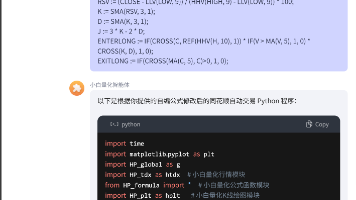调用大模型api,实现基于rag的回复
【代码】调用大模型api,实现基于rag的回复。
·
import numpy as np
from openai import OpenAI
import torch
import torch.nn as nn
import torchtext
torchtext.disable_torchtext_deprecation_warning()
from torchtext.data.utils import get_tokenizer
from torchtext.vocab import GloVe
# 填写密钥即可
models = {
"moonshot-v1-32k": {
"api_key": "",
"base_url": "https://api.moonshot.cn/v1",
},
"yi-large-turbo": {
"api_key": "",
"base_url": "https://api.lingyiwanwu.com/v1",
},
"generalv3.5": {
"api_key": "",
"base_url": "https://spark-api-open.xf-yun.com/v1",
},
"glm-4-flash": {
"api_key": "",
"base_url": "https://open.bigmodel.cn/api/paas/v4/",
},
"glm-4-plus": {
"api_key": "",
"base_url": "https://open.bigmodel.cn/api/paas/v4/",
},
"Baichuan2-Turbo": {
"api_key": "",
"base_url": "https://api.baichuan-ai.com/v1/",
},
"qwen-max": {
"api_key": "",
"base_url": "https://dashscope.aliyuncs.com/compatible-mode/v1",
},
}
def get_client(model_name):
assert model_name in models, "model name not found in models.py"
model = models[model_name]
client = OpenAI(
api_key=model["api_key"],
base_url=model["base_url"],
)
return client
# 预加载GloVe模型
glove = GloVe(name="6B", dim=300)
embedding = nn.Embedding.from_pretrained(glove.vectors)
# 不依赖于kb类的实例,不必作为类的方法
def get_word_vector(word):
"""获取单个词的向量表示"""
if word in glove.stoi:
index = glove.stoi[word]
vector = embedding(torch.tensor([[index]])).detach().numpy()
else:
vector = np.zeros((1, 300))
return vector
class KnowledgeBase:
def __init__(self, file_path):
self.docs = self.load_docs(file_path)
self.embeds = self.encode_docs(self.docs)
@staticmethod
def load_docs(file_path):
"""加载文档并分割为段落"""
with open(file_path, "r", encoding="utf-8") as file:
content = file.read()
return [content[i : i + 150] for i in range(0, len(content), 150)]
@staticmethod
def tokenize(text):
"""使用基本英文分词器进行分词"""
tokenizer = get_tokenizer("basic_english")
return tokenizer(text)
def encode_docs(self, texts):
"""将文档列表编码为向量"""
return np.concatenate([self.encode_text(text) for text in texts], axis=0)
def encode_text(self, text):
"""将单个文档编码为向量"""
words = self.tokenize(text)
word_vectors = [get_word_vector(word) for word in words if word in glove.stoi]
if word_vectors:
return np.mean(np.vstack(word_vectors), axis=0).reshape(1, -1)
else:
return np.zeros((1, 300))
@staticmethod
def cosine_similarity(e1, e2):
"""计算两个向量的余弦相似度"""
dot_product = np.dot(e1, e2)
norm_e1 = np.linalg.norm(e1)
norm_e2 = np.linalg.norm(e2)
return dot_product / (norm_e1 * norm_e2)
def search(self, text):
"""搜索最相似的文档"""
query_vector = self.encode_text(text)
similarities = [self.cosine_similarity(query_vector, te) for te in self.embeds]
max_similarity_index = np.argmax(similarities)
return self.docs[max_similarity_index]
class RagModel:
def __init__(self, model_name, kb: KnowledgeBase):
self.model_name = model_name
self.kb = kb
self.prompt_template = "基于:%s\n回答:%s"
def chat(self, message):
"""与模型进行对话"""
context = self.kb.search(message)
query = self.prompt_template % (context, message)
print("query:", query)
client = get_client(self.model_name)
completion = client.chat.completions.create(
model=self.model_name,
messages=[{"role": "user", "content": query}],
temperature=1,
)
return completion.choices[0].message.content
# 实例化知识库
kb = KnowledgeBase("knowledge.txt")
# 实例化RAG模型
rag_model = RagModel("yi-large-turbo", kb)
# 与模型进行对话
while True:
user_input = input("human >>> ")
if user_input.lower() == "exit":
break
bot_response = rag_model.chat(user_input)
print("bot >>>", bot_response)
更多推荐
 已为社区贡献2条内容
已为社区贡献2条内容









所有评论(0)